SanDisk Extreme Pro v2 SSD review
-
-
Written by Gordon Laing
The SanDisk Extreme Pro Portable SSD v2 is a rugged, pocket-sized USB drive that exploits the size, speed and robustness of the latest solid state storage. It works with Macs and PCs, as well as compatible phones, tablets and consoles, and is available in 1 or 2TB sizes.
I tested the latest 1TB version, launched in September 2020, which claims speeds up to 2000 Megabyte/s – although the maximum performance will only be attainable on devices with the fastest USB ports as I’ll explain later. It’s also really important to check the quoted speed of the drive when ordering one, as SanDisk has so far made several versions of its portable SSDs, rated between 550 and 2000 Megabyte/s. The slower models are cheaper and may be good enough – the last one I tested was an Extreme v1 250GB model 18 months ago rated at 550 Megabyte/s which still feels pretty fast to me today. Let’s see how much faster the Extreme Pro v2 model is, and crucially who’ll benefit from its faster speeds. Everything is in the video below, but if you prefer to read a written version, keep scrolling down!
Before delving into the actual performance in real life, why would you want a portable drive in the first place? Well, they’re invaluable for backing-up your data, transporting large files or collections, or simply freeing-up space on a full computer so you can complete a project. I’ve relied on a small fleet of portable drives for years, from providing backup I can take offsite, to actually hosting assets for large video projects. Portable SSDs have become fast enough for you to edit video straight off them, coming close to – or even matching – the speeds of internal drives. I also find them invaluable for getting photos and videos off or onto my phone and tablet, while gamers may use them to expand storage. Some high-end cinema cameras can also record directly to SSDs, although do check for specific compatibility first as they can be fussy.
Older spinning hard disks still work out cheaper than SSDs – at the time I made this video, you could buy a 4TB Western Digital My Passport for a little less than the cheapest 1TB portable SSD and less than half the price of the 1TB Extreme Pro v2 drive I’m testing here, while boasting four times the space of either. Hard disks aren’t as fast, nor as compact as a portable SSD and are also more vulnerable to knocks, but remain compelling value for money. I still use them for offsite backups of my photo and work collections, but I’ve now switched to SSDs for tasks where speed and pocketability are more important.
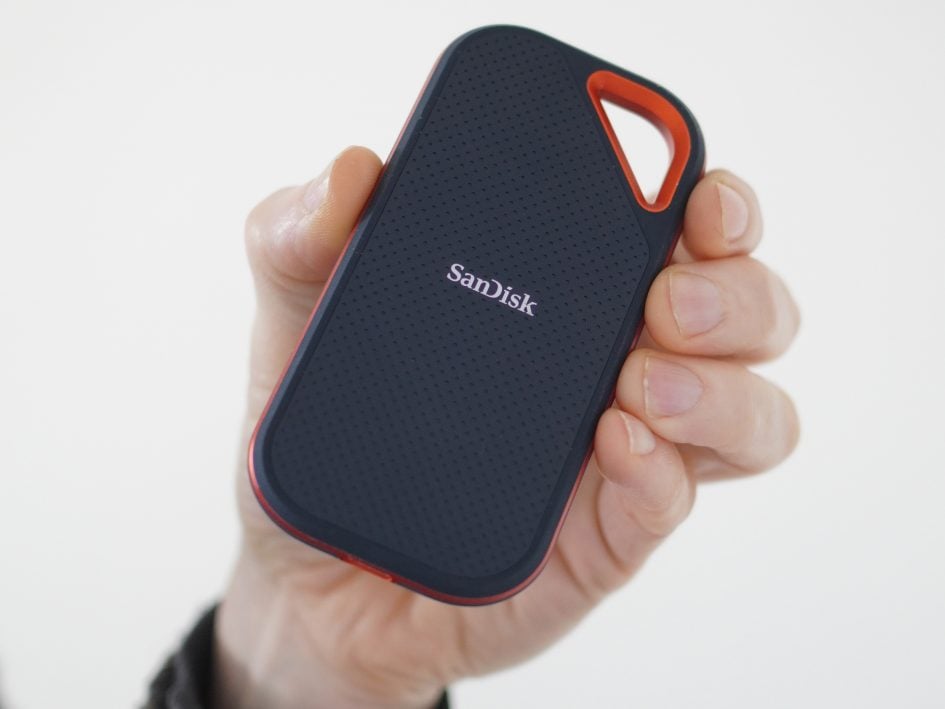
Ok, so how does SanDisk’s latest drive measure-up? The Extreme Pro v2 measures 110x57mm – that’s just a bit longer than a credit card – and is just over 10mm thick. It’s similar in thickness to a modern phone but much smaller overall and at 84g, much lighter too, so it’ll easily slip into almost any pocket.
Much of what differentiates one portable drive from another is the case and finish, and SanDisk has once again gone with a rugged style sporting silicon on the rear for grip and rounded corners for comfort in your hands or pockets. There’s also a handy cut-out allowing you to attach it to a keyring or hang-off a caribiner or D-ring. Most usefully of all though is the IP-55 rating for water and dust resistance. Before you get too excited, you can’t submerge the drive in water and expect it to survive, but it should shrug-off mild splashes, rain or moisture, so long as you’re careful not to expose the port. It also offers reasonable protection against shock and vibration – SanDisk claims it’ll survive a 2m drop – and again while it’s not invincible, it will better-protect your data from knocks and small falls than a mechanical hard disk.
Like all modern portable drives, there’s just one USB port used for data transfer and to power the device. SanDisk has sensibly opted for the latest USB C port, supporting USB 3.2 Gen 2×2 (theoretically boasting up to 20Gbit/s of bandwidth) but it’s also backwards compatible with USB 3 and USB 2 devices, albeit with a reduction in speed. Rather than supplying a single cable with an adapter for older ports as it did on the older Extreme drives, SanDisk now supplies the Extreme Pro with two cables, one ending in a USB C plug and the other ending in USB A. Much more convenient.
While the latest Extreme Pro drives are pocket-sized, they have grown noticeably compared to the previous Extreme models. Here’s the newer Extreme Pro on the left next to the plain Extreme on the right which measures just 50mm wide, 96mm tall, 9mm thick and is half the weight at 40g. You’ll also notice the cutout shape is a different and smaller shape, and that the USB port on the old model is positioned to one side compared to the middle of the new one, and the older model has a slower USB interface too. Size and cutouts aside, one of the most obvious identifiers between them is the orange stripe around the edge of the newer Extreme Pro models. These design cues all help you find the right model, although remember the Extreme Pro is also available in 1050 and 2000 Megabyte speeds, so you’ll need to check the box too.
Not only is the Pro model now supplied with two cables, but they’re longer than the cable supplied with the older Extreme. Some complained about the short length of the old cable, but I actually preferred it for dangling less obviously from a laptop than the new one. Technically speaking, shorter cables are sometimes necessary for the fastest speeds, but I tried the new drive with both cables and measured no difference, at least on my computer.
Ok now for performance, with the latest Extreme Pro v2 employing an NVMe SSD with claimed read and write speeds up to 2000 Megabyte/s. I tested it on my fastest computer, a 2018 MacBook Pro which has USB 3.1 Gen 2 ports rated up to 10Gbit/s, which works out at 1250 Megabyte/s. Given this is a theoretical bandwidth and in practice more likely to be closer to 1000 Megabyte/s, it represents a significant bottleneck for the Pro v2 drive, allowing only roughly half its maximum data rate to pass. But don’t assume a newer MacBook will be any better as the USB ports on the late 2020 models are still restricted to 10Gbit/s. Indeed if you want a 20Gbit/s USB port at the time I made this review, you’ll need to buy a USB 3.2 Gen 2×2 expansion card for a desktop PC which specifically quotes support for 20Gbit/s, or wait for laptops with faster ports to arrive – it pays to check the specs of your system very carefully, especially as labelling of USB ports can be very confusing.
Across multiple runs on the Pro v2 drive, the BlackMagic Disk Speed Test utility measured between 940 and 960 Megabyte/s for both reads and writes, whether using the 1GB or 5GB stress size. These scores are definitely being restricted by my MacBook’s USB ports, but are still roughly double what I measured from the earlier Extreme v1 drive, which itself was already four times faster than the spinning hard disk in my WD My Passport 4TB drive.
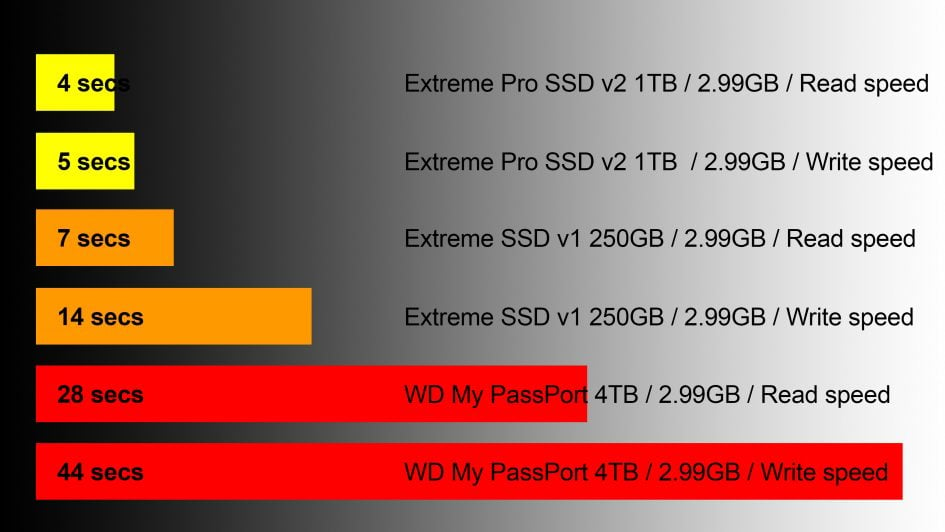
In real-life tests, I first timed the transfer of a 2.99GB folder containing 177 JPEG and RAW images. The earlier Extreme v1 took 14 seconds to write the data from my Mac onto the drive, then, following a restart, seven seconds to read it back from the drive. In contrast, the Extreme Pro v2 took just over five seconds to write the data to the drive and just under four to read it back again. Just compare them to my 4TB Passport drive which took 44 seconds to write the data and 28 to read them back.
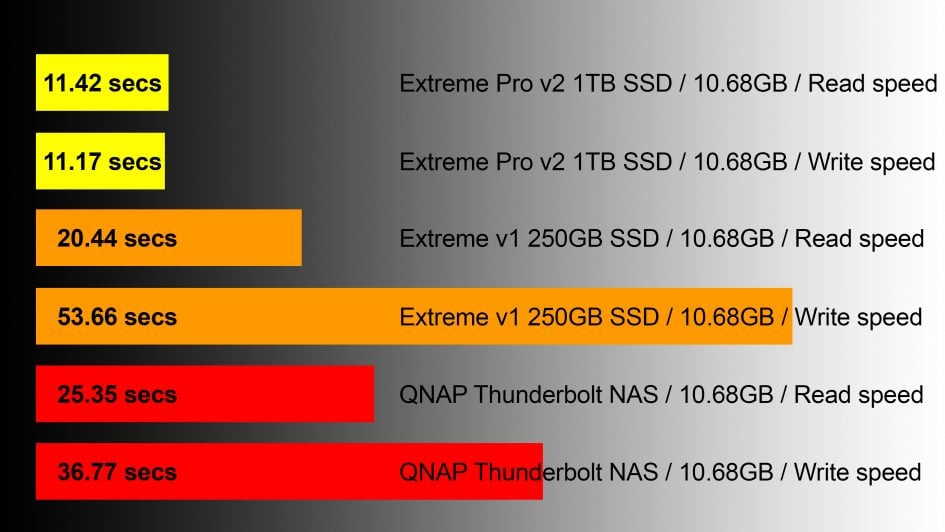
I also tried copying a single large video file measuring 10.68GB which took 54 seconds to write and 20 seconds to read on the Extreme v1, but a mere 11.2 seconds to write or 11.4 seconds to read on the Extreme Pro v2 drive. Again the almost identical figures for read and write performance of just under 1000 Megabyte/s indicate a bottleneck, in this case my USB port, but it still remains much faster than my older Extreme v1.
I also tried editing entire 4k video projects directly from the drive with no performance issues on both my Mac laptop as well as my iPad Pro running Lumafusion as seen here, although this was also possible with the older Extreme v1 drives. It also worked well when connected to my Samsung Galaxy S20 phone for copying large amounts of photos or videos to and from it. I didn’t get to try it on a games console or cinema camera though, so I’d recommend checking for compatibility with specific models.
During sustained use, I found the Extreme Pro v2 generally became warmer than my previous Extreme v1 drive – not exactly hot, but definitely very warm. SanDisk’s employed an aluminium chassis to act as a heatsink and it’s certainly transferring the heat evenly across the case, unlike the previous Extreme v1 which only tended to warm-up around the port area. Either way, I experienced no issues regarding heat, but do be aware the Pro v2 will get warm in constant use.
SanDisk Extreme Pro v2 verdict
As a photographer, I love using Portable SSDs as quick, compact and robust backup drives. At the end of a day’s shooting, I copy the card onto my laptop, then duplicate it onto the SSD. I’d then keep the SSD in a separate location to my computer, such as in a hotel safe when I was out with the laptop. The speed of the drive means you’ll never neglect performing backups, the size means you’ll always have it with you when you need it, and the robustness means you don’t need to treat it with kid gloves. I can literally throw it into a bag or slip it in a pocket and not worry.
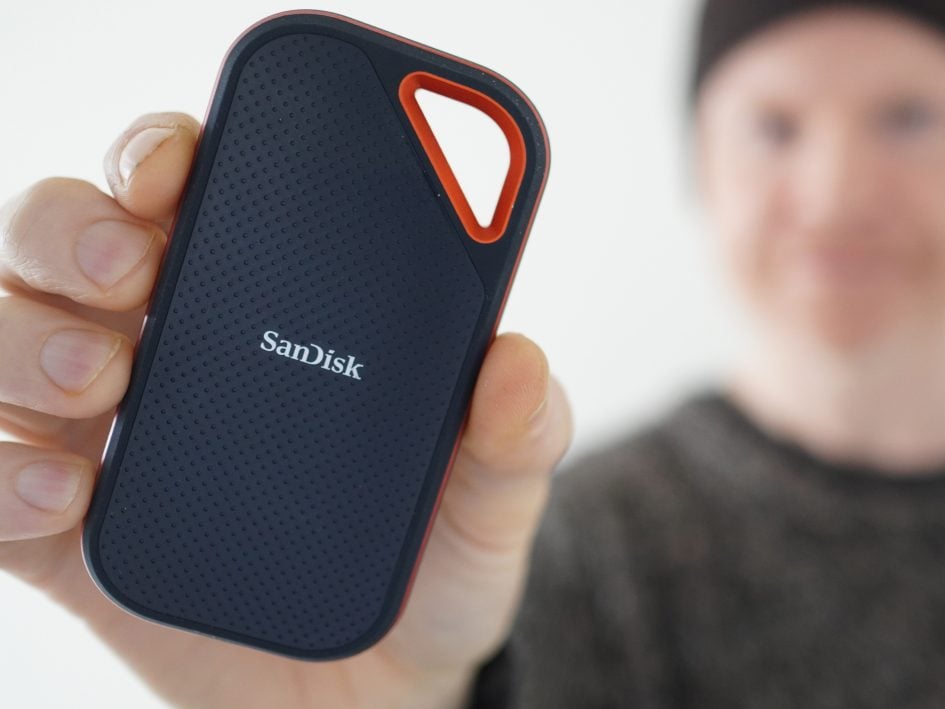
As a video editor, I often find myself with giant folders of footage quickly consuming the internal drive on my laptop. Previously I’d free-up space by copying projects I wasn’t currently working on to portable drives or network storage, but the slow speed meant a huge folder could take so long to copy, it felt more like archiving. But with the SSD I can rapidly transfer huge folders back and forth. It’s so fast I can even work directly from the drive whether it’s storing regular assets, an output render or even an entire project. Now the low disk space warning no longer means I’m out of action.
Wherever I worked, I also liked how the drive was small and light enough to happily dangle from the end of its cable, without demanding flat desk space to rest on. You can even pick up your laptop with it still dangling without troubling the drive or your ports. It’s so convenient when you’re literally working off your lap in a cafe or on a plane or train and need to get up or move around.
But if you’re getting a sense of deja-vu, it’s because I made the same conclusion at the end of my Extreme v1 review. All of the above is perfectly possible with an SSD rated at 550 Megabytes/s, it’s just that the newer Pro v2 can theoretically do it four times faster still. Thing is at the time of writing, most people won’t be able to enjoy the top speed as their USB ports simply won’t be up to the job. Not only will you need a USB 3.2 Gen 2×2 port, but one that specifically supports 20Gbit/s speeds, and that rules-out even the late 2020 Apple laptops. So for many of us, the Pro v2 drive will only work out twice as fast as the 550MB/s models.
Indeed since SanDisk charges a premium for the Pro v2 performance, I wish they’d make a Thunderbolt 3 version as this interface supports up to 40Gbit/s even on Macs from 2016. But by adopting the latest USB spec, there’s not a lot of devices able to yet exploit the top speed. Of course this gives the drive some degree of future-proofing, but the simple fact is most people won’t see a difference between the Extreme Pro v2 and cheaper drives rated up to 1000 Megabyte/s, like the Extreme Pro v1 or Extreme v2 models.
Ultimately backing up your data, whether it’s photos, videos, music or plain old documents, is critically important, and a crucial part of that process is transporting the backup to a different location – after all, fire, flood and theft will rarely take one drive but leave the backup next to it unharmed. This is why portable drives are so useful. They can store and transport a large quantity of data quickly and easily – just one USB cable will transfer the data and power the drive, and once complete, they’re small enough to slip into a jacket or even trouser pocket. Their portability also makes them great for providing more storage for laptop owners who have filled their internal drives, but aren’t ready for a system upgrade quite yet.
The earlier SanDisk Extreme Portable SSD quickly found itself part of my workflow thanks to its speed, size and robustness, all of which meant I never had an excuse not to use it. It became my go-to backup when I’m out and about, and a convenient way to boost the storage on my laptop when working on big projects. The newer Extreme Pro v2 provided the same flexibility but with the benefit of faster speeds, and while my own devices meant I only enjoyed half its theoretical performance, it remains the fastest drive I’ve tested. As such unless I expected to buy a computer with a 20Gbit USB port in the future, I’d personally save money and buy a model rated at 1000 Megabyte/s like the Extreme Pro v1 or Extreme v2 instead. But the bottom line here is regardless of model, I’ve come to regard a portable SSD as an essential accessory, and the SanDisk range provides an ever-growing choice of speeds, capacities and price. Buy the one that best matches your needs, but check the specs of the drive and your ports carefully.
Check prices on the SanDisk Extreme Pro Portable SSD at Amazon, B&H, Adorama or WEX! Alternatively get yourself a copy of my In Camera book or treat me to a coffee! Thanks!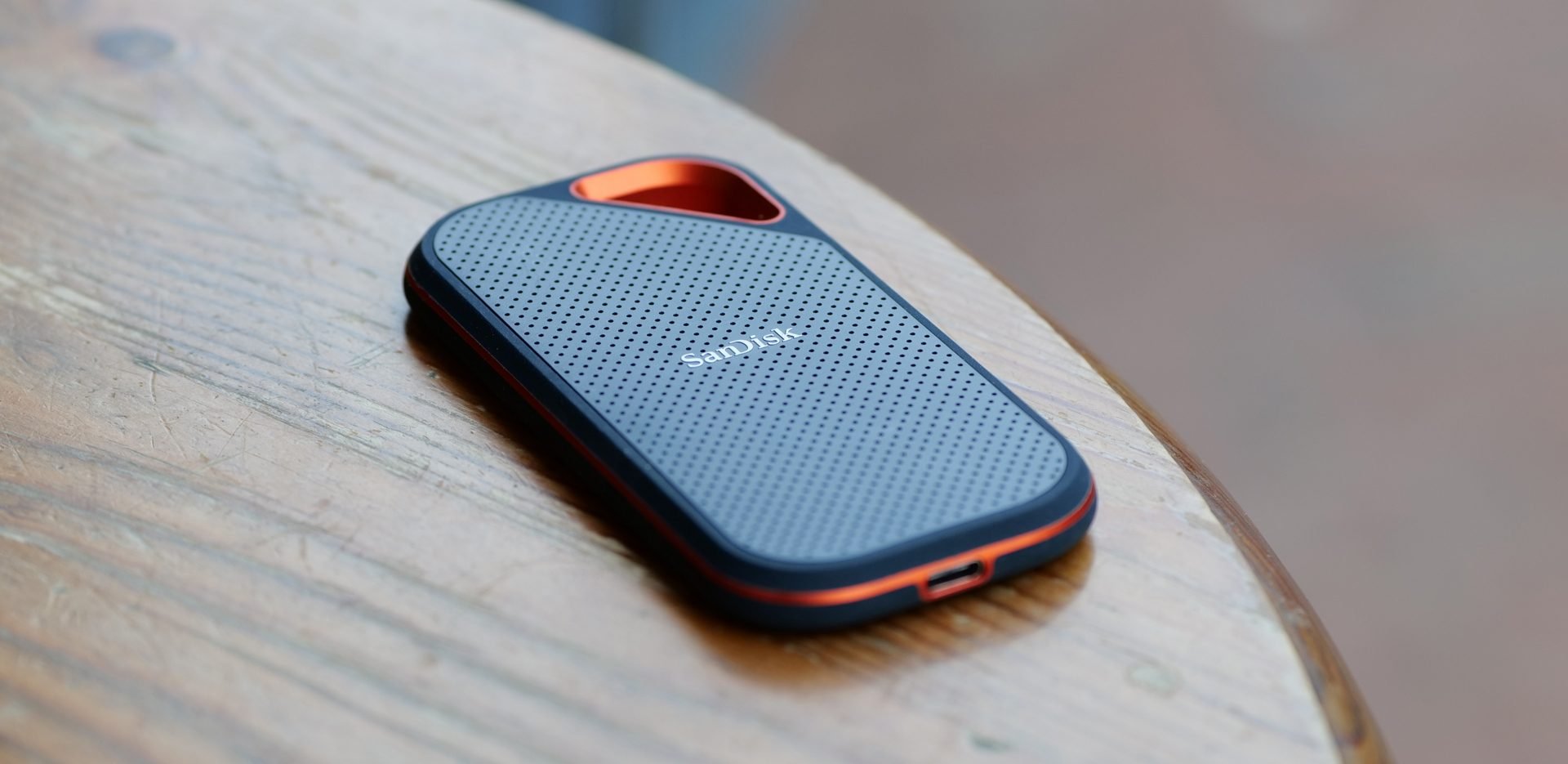
 The SanDisk Extreme Pro v2 Portable SSD is a rugged, pocket-sized drive that connects to new and old USB ports and boasts read and write speeds up to 2000 Megabyte/s. It works with Macs and PCs, as well as some phones, tablets, games consoles and even cinema cameras, but do check for compatibility. It’s compact, easily slipping into any pocket and the absence of moving parts makes it more robust and tolerant than mechanical drives. The IP-55 rating shrugs-off mild splashes, while the lightness means it can dangle from its short cable without damaging your ports - ideal for laptop workers who have to get up or move around. But it’s the speed that really impresses - when connected to common USB 3.1 Gen 2 ports rated at 10Gbit/s, such as those on modern Macs, I achieved actual data rates approaching 1000 Megabyte/s for reads and writes, making it possible to edit demanding video straight-off the drive, or copy large folders of images quickly. The Pro v2 models are actually capable of faster speeds still, up to 2000 Megabyte/s, but you’ll need a USB 3.2 Gen 2x2 port specifically rated at 20Gbit/s and these are rare at the time of testing. So unless you intend to get a new computer, laptop or expansion card with 20Gbit/s USB ports in the future, I’d save a little money and go for the Pro v1 drives rated at 1050 Megabyte/s. Whichever model you choose though, I strongly believe everyone needs at least one portable drive, and if you value speed, size and robustness, SanDisk’s Extreme range is a compelling proposition at a variety of speeds, sizes and prices.
The SanDisk Extreme Pro v2 Portable SSD is a rugged, pocket-sized drive that connects to new and old USB ports and boasts read and write speeds up to 2000 Megabyte/s. It works with Macs and PCs, as well as some phones, tablets, games consoles and even cinema cameras, but do check for compatibility. It’s compact, easily slipping into any pocket and the absence of moving parts makes it more robust and tolerant than mechanical drives. The IP-55 rating shrugs-off mild splashes, while the lightness means it can dangle from its short cable without damaging your ports - ideal for laptop workers who have to get up or move around. But it’s the speed that really impresses - when connected to common USB 3.1 Gen 2 ports rated at 10Gbit/s, such as those on modern Macs, I achieved actual data rates approaching 1000 Megabyte/s for reads and writes, making it possible to edit demanding video straight-off the drive, or copy large folders of images quickly. The Pro v2 models are actually capable of faster speeds still, up to 2000 Megabyte/s, but you’ll need a USB 3.2 Gen 2x2 port specifically rated at 20Gbit/s and these are rare at the time of testing. So unless you intend to get a new computer, laptop or expansion card with 20Gbit/s USB ports in the future, I’d save a little money and go for the Pro v1 drives rated at 1050 Megabyte/s. Whichever model you choose though, I strongly believe everyone needs at least one portable drive, and if you value speed, size and robustness, SanDisk’s Extreme range is a compelling proposition at a variety of speeds, sizes and prices.



